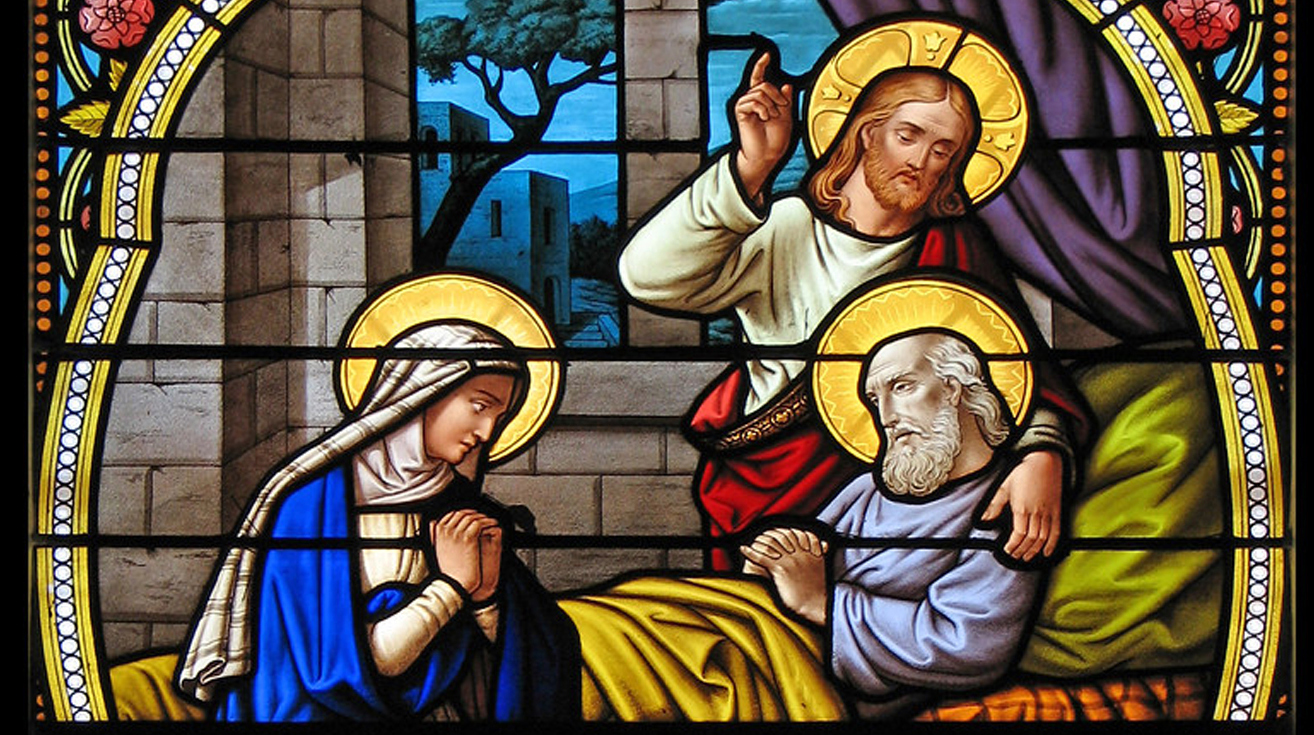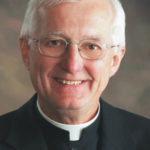
This stained glass window in Lourdes, France, depicts Jesus and Mary at the deathbed of St. Joseph. St. Joseph is the patron saint of a happy death.
By Lindsay Steele
The Catholic Messenger
Father Timothy Regan, a chaplain at University of Iowa Hospitals and Clinics in Iowa City, regularly ministers to dying individuals and their families.
The desire to “go peacefully, have a happy death or something similar” is prevalent among the people he encounters in ministry. Often, death is something people don’t think about, talk about or prepare for until it is imminent.
“We like the comforts of life. We don’t want to face the reality of death,” said Father Terry Ball, a chaplain at Mercy Iowa City who lost his wife, Mona, to cancer prior to entering the priesthood. “The reality in the minds of many people is that other people die, not them.” Humans like to be in control, and death is “the ultimate thing we can’t control.”
Even with the hope of eternal life in Christ, the process of dying may be difficult — not just physically, but emotionally. Father Ball observes that dying individuals mourn the experiences they will never have, and think about what they wish they could have done differently.
St. Joseph: patron of a happy death
A fifth century apocryphal book, The History of Joseph the Carpenter, offers a glimpse of the feelings Joseph may have experienced on his deathbed. According to the book, Joseph was afraid of dying and saddened that he had not accomplished more in life. Mary and Jesus comforted him and promised protection and life to everyone who did well in Joseph’s name, and with these assurances, Joseph was able to die in peace — a happy death.
While this story is likely a legend or myth, according to Deacon Frank Agnoli, diocesan director of Liturgy and of Deacon Formation, the Catholic Church has nevertheless embraced St. Joseph as the patron of a happy death. Through this story, “the faithful could see themselves in Joseph, and perhaps hope for the same sort of visitation and comfort.”
What a happy death looks like
What a happy death entails looks a little different for everyone, though some common themes have emerged. For some, the prospect of a happy death centers around perceptions that loved ones are in a good position to carry on after their departure, Father Regan said.
Father Ball said this assurance might be especially difficult for someone who has minor children at home. The thought of not being around to raise them is devastating. A mantra such as “Jesus, I trust in you to care for and protect my family” can offer some comfort.
Another frequently expressed concern is of “being right with God,” Father Regan said. There may be something in the dying person’s past that he or she wants to bring forward for reconciliation, and receiving God’s forgiveness can help them “find the release they need to embrace death as it comes. Other sacraments, including anointing of the sick and Eucharist, are very much appreciated here.”
A happy death requires a level of acceptance and surrender that can be difficult for some people to achieve, Father Regan said. “Those who are actively dying may express that they aren’t ready,” and focus on “fighting to the end” instead of making steps to come to terms with it. “For them, sadly, death is seldom happy.”
The hope of what is to come can offer comfort to dying individuals and their family members, Father Regan said. Death offers the opportunity to be reunited with deceased loved ones; the opportunity to enter into the vastness of eternal perfection and the presence of God; and the opportunity to shuffle off the mortal coil with all its difficulties and pains, especially in the presence of a long and debilitating illness. “On the personal level, I most fully embrace the second of the opportunities listed above. I have sensed the merest glimpse of what this perfection may be like and I long to embrace it in its proper time. I have also experienced profound moments of God’s very personal love for me as an individual and eagerly await that time when I can enter into its fullness.”
The road to a happy death starts now
Inevitably, some aspect of death will bring sadness to the dying individual or their family members. Still, acknowledging that death will inevitably come — maybe tomorrow, maybe years from now — can help people prepare for it, Father Ball said. People seem to be much more at peace when they feel confident that “they have respected (the teachings of Christ) and know they are ready to embrace what’s coming forward.”
Because death could happen at any time, Father Ball encourages everyone, regardless of age or health status, to take the time to tell others that they care about and love them, reconcile broken relationships when appropriate, and make plans for how they want to distribute assets and other “loose ends.”
Father Regan, too, urges people not to wait until death is imminent to seek peace, forgiveness and faith. “In a very real way, we are all in the process of dying, as our faith reminds us, and so ought to be working to achieve whatever markers we might use to accomplish this.”











